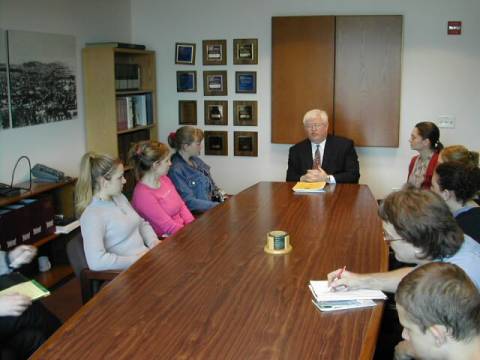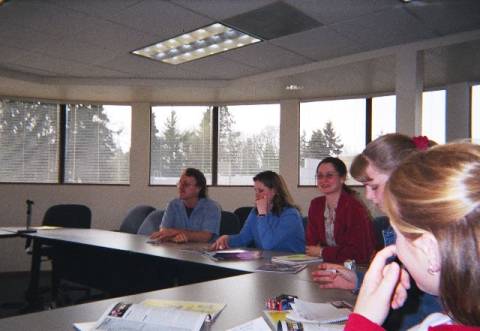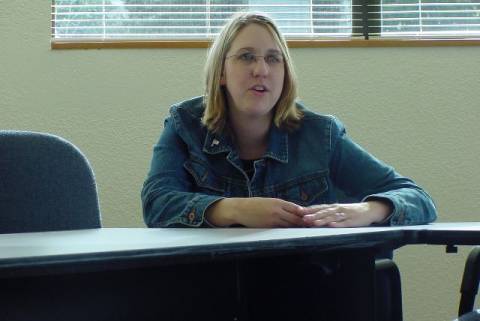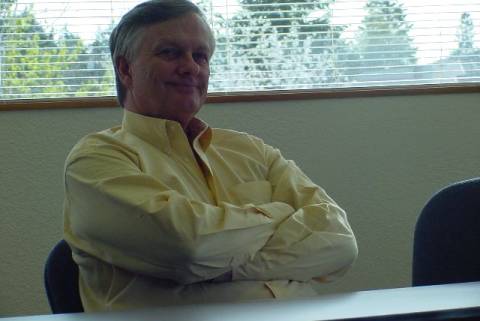Eastern Oregon Research Center
The first place we stopped was at the Eastern Oregon Research Station which is a branch of OSU's college of Agricultural Science. Their mission is to develop agricultural and natural resource strategies that maintain or enhance forest and shrub ecosystems that may benefit present and future generations. We spoke to Tony Svejcar first about expansions of different species of plants, water quality and how fire can be used as a tool. He mentioned that fire is necessary for some plants to grow and sometimes just to clean up the vegetation on the land. Next we spoke to David Bonnert also about water quality. He explained how the clean water act affects how people manage their cattle on land with streams. He gave us an idea on how a stream of good quality should look like. He also presented slides to us of what land with proper grazing techniques should look like.
April 9, 2003

Southworths range and cattle. [Photo by: By Veronica Ayers]

A mountain view, cattle and range from southworth ranch. [Photo by: By Veronica Ayers]

A front loader and feed wagon at Southworth Ranch. [Photo by: By Veronica Ayers]

Jack Southworth speaking to Harney County students.[Photo by: By Veronica Ayers]
On April 9 we visited the ghost town of Shaniko. It's not completely empty, but it is just about especially compared to its former glory days. Shaniko use to be a booming sheep based products center. It was the major producer of sheep wool in the USA while the railroad ended there. After the railroad continued on its way Shaniko started shrinking. Today the once prosperous city is now nothing more than a few old buildings visited by curious tourists. The old buildings of the town aren't the only attractions that attract tourists to the area. The haunted hotel attracts people who want to have an encounter with the ghosts that are reported to reside in the hotel. Guests report strange noises in the night when they are alone such as water running and radios playing when there are no other guests in the hotel. Radio noises could be easily dismissed, except for one fact. There are no radios or televisions in any of the rooms. The girls on our trip got scared and ran back to the bus after having an “encounter” with a ghost. Personally I think they scared themselves.
We went to the discovery center on Thursday morning. It was the first time we had stopped there. We stopped there to basically learn about the formation and how the dam works. As we walked through we got to see different cultures like the pioneers and the Indians of the area and how they co existed. The best part for Jamie, Christa, and Tarah was getting to play dress up in the pioneer clothes, and play in the old car that was in the museum.we also watched a video that was about the gorge.
Jamie, Christa, And Tarah practicing their driving skills in a very old car
that
was in the museum. [Photographer Unknown]
Our first stop was at the Bonneville Dam and Hatchery on Thursday. Our first visit was the fish ponds where we saw the young salmon being raised. We fed the rainbow trout in the fish ponds and witnessed the giant 17 foot sturgeon. We then ventured to the Dam where we saw many salmon making their way through the fish ladder. Counts suggest record numbers of salmon have passed through the ladder this year. Some of the salmon were huge. We also saw seals playing in the water below the dam and undoubtedly looking for a salmon snack.
The
dam was
a very educational place to visit. We learned about chinook, salmon, and
steelhead and how they travel up the fish ladders.
We also learned about their population and how the dams affected their
migration. Seeing the sturgeon ponds was also exciting.

[Photographer Unknown]
During our field trip we stopped at many places along The Columbia River Gorge. We had lunch and a geolical discussion, at Latourell Falls.[Williams 1991]
|
Gorge and Crown Point. (Photo: Eric Garner) |
. The falls were beautiful, and a lot greener and more humid than we were used to.
The gorge was created by Bretz floods[Allen and others 1986]. The crests of the floods dropped in elevation from 1000 feet at the Dalles to 700 feet at Crown Point.
Transportation of cattle through the gorge would have been very difficult! Cattle could fall off of the cliffs, or be swept away by the swift rivers. Cattle were trailed over the Barlow Road to the stockyards to avoid the gorge. Later on, the railroad was built to help transport cattle and other goods to Portland.
|
Lunch (left to right): Bob, Carol, Christa, Eric, Jamie, Becka, Mandy, and Tarah. (Photo: Jimmy Zamora) |
|
|
Eric, Marlon, Jamie, and Christa on top of Laourell Falls. (Photo: Jimmy Zamora) |
|

The Rain Man and Tarah Mccanna, taken in downtown Portland. [Photo by Jamie Moline]
The experience in Portland was great. The way of life was so different from how we live in our rural communities. The population was so much bigger and so much more diverse from ours. It was so exciting and so different from what we are used to. It is so unique and has such a larger culture and such a larger pick and choose from what we have in burns. For example, just entering Portland was so crazy there were buildings all over. Then getting into town there were cars all over and Taxi cabs people honking at each other. The people looked like they were trying to get somewhere in a 90mph race.

[Photographer Unknown]
The Oregonian is the largest daily newspaper and also the oldest in the Pacific Northwest. Stephanie Oliver took us up to one of the conference rooms where we met with the editor Robert Caldwell and a couple of his associates. They clued us in how the newspaper works and how we can submit articles and other written materials to be published in the newspaper. We also discussed different ways of getting our message across to the general public. They were very helpful and patient with our questions. Most of the students were too hesitant to talk much, but Chance and the teachers filled in any gaps in the conversation. We left with a lot of useful information and polished plans to help spread our message around. This is of course one of the many ways we are going to spread our message to the public.

Robert Caldwell editor of the Oregonian on the left and Nana of the field trip to the right. Robert told us about different ways to submit written material to the newspaper and discussed current issues in Oregon with us. [Photographer Unknown]

This is a picture of us at the meeting with Robert Caldwell. He and a couple of his associates, not shown in this picture, answered our questions and were great sources of help and information. [Photographer Unknown]
On Friday April 8, 2003, we had a visit at the Senator, Gordon H. Smith's office for the second time. We talked with Deputy Director of Natural Resources, Martin Doern, and Field Representative, Richard A. Krikava. We talked about issues in Harney County such as Steens Mountains, SMAC (Steens Mountains Advisory Committee), Logging and Wilderness.
Oregon Cattleman's Association
On April 11, we had a meeting with Katie Cate and Glen Stonebrink of the Oregon Cattlemen's Association. We had a discussion with them about the current conditions of the cattle industry. Mainly among the various topics we centered on the various lawsuits that have been filed over the years and about the Steens Mountain issue. In a related story to the lawsuits that were discussed Glen had an interesting story to tell us. The story involved a ranch, a river, environmentalists, and a road. The rancher used the river to water his cows and the environmentalists didn't like this so they filed a lawsuit to remove the cows from the river. The rancher didn't really care about watering his cows at the river as long as he could pipe water to high ground where most of the feed was. There was one problem to his plan though. He needed a road to put in the pipe that would carry the water to high ground. The only thing that resembled a usable road was an old unused road that was almost impassable. This would have put an end to the rancher's plan, except for an old mining law that stated that that road was still under county control even though it had been many years since it was maintained. The judge presiding over the lawsuit dug up this law and ordered a "road grater" to make it usable again. This was done quietly and the environmentalists only learned of it after the fact. Of course they were quite unhappy about this and threatened the grater operator and the judge with lawsuits, but of course they turned out to be hollow threats because the environmentalists knew they would lose in a court battle against a judge with a law to support him. This is a true story. Glen can tell stories a lot better than me, but hey I had to try.

This picture was taken at the Oregon Cattlemen's Association meeting room in Salem. We discussed the current condition of Steen's Mountain and recent lawsuits filed against cattlemen. Listed from left to right, Bob, Ms. Pimm, Nona, Veronica, and Tiffany. [Photo by: by David Wright]

This is a picture of Katie Fast of the Oregon Cattleman's Association. She helped to explain the current conditions of rangeland in Oregon. Among these were the conditions of certain wilderness areas and other current issues such as some of the court battles over grazing and water rights. [Photo by: by David Wright]

Glen Stonebrink of the OCA. He told us about some of the issues in Oregon concerning agriculture. Among the issues were the lawsuits that affected farmers and ranchers. He even had an interesting story to tell concerning one of the lawsuits, if you haven't read it yet be sure to. [Photographer Unknown]
Once again we came to Oregon State University on Saturday morning, to work on creating this year's virtual tour. We worked with Bob, Albert, and Nana. They helped us select pictures and edit our work .Then a few of us got to go on a tour of the school and we got to go through the main agriculture buildings, see the green houses and buildings and ...
This is the library at Oregon State University where we spent the majority of our time preparing our website to be placed on the web. [Photographer Unknown]



